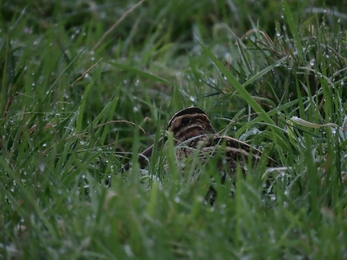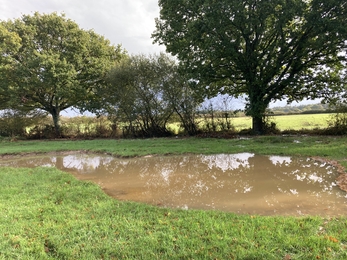When I first walked around Wild Woodbury it was clear to see it was a heavily altered landscape. Missing hedges, bright green fields, and large ditches all pointed towards an intensively managed agricultural past – something which isn’t usually conducive to a biodiverse-rich setting. The ditches were startling, with many being over two metres deep and bordering almost every field margin, forcing any water on the land to be quickly washed away into a nearby river. These highly managed and canalised systems are now commonplace across the UK, drying our land out, whilst forcing nutrient rich waters into our rivers and seas, decimating wildlife along the way.
A major part of rewilding is the restoration of natural processes, which for us at Wild Woodbury means a site-wide project to restore the waterways across the 420-acres of land. Much of the site is fed by three springs and should naturally be very wet, encompassing several fields and a wet woodland, but the ditches have made this not so. To undo this previous management, we are carrying out a process called Stage-0 River Restoration. To begin with, this is very simply pushing the water out of the ditches and letting it flow over the land, letting it find its own pathways and naturally re-establishing historic routes across the fields. We estimate this will create 100-acres of wetter land, but in what form we are not yet sure – it could be standing water, marshy areas, meanders… One of the exciting parts of this work is watching and being surprised by what happens.
Before we started filling in ditches, we commissioned a hydrologist to survey Wild Woodbury for us, mapping the historic flow paths, monitoring the amount of water travelling through site and creating a plan of where would be most effective to block ditches and spill water back into the landscape. The filling in process has been rather straightforward, with one digger on site for a few weeks pushing material into the ditches in these specified locations, before we supplemented this work by creating leaky dams throughout the remaining ditch systems. Leaky dams, the well-known structure built by beavers, would be in every waterway throughout the country were it not for their extinction caused by over-hunting in the 16th Century, but as we wait for their welcome comeback to spread, we are being human beavers and creating dams ourselves. The idea of a leaky dam is to hold back a large proportion of water, but let some slowly move through the dam, to create a wetland system which is much more resilient to drought, filters excess nutrients out of water, and helps alleviate flash flooding downstream.









